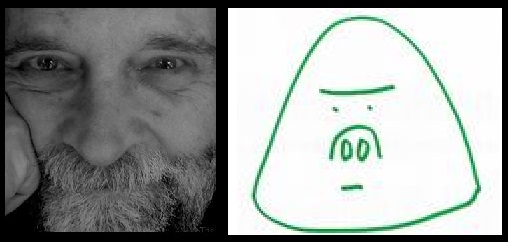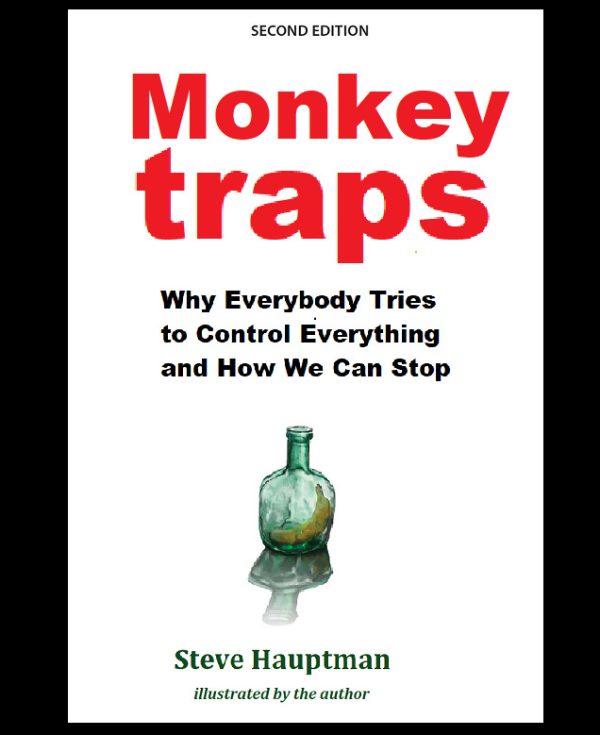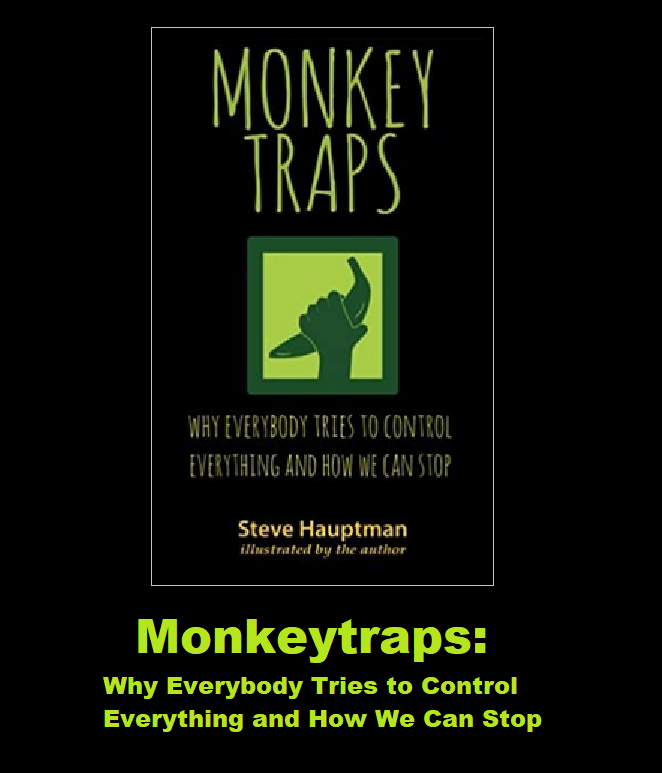(If you’re new to Monkeytraps, Steve is a therapist who specializes in control issues, and Bert is Steve’s control-addicted inner monkey.
Bert speaking:)
I’d like to introduce you to my dog.
Please look down. You’ll find him attached to my ankle.
That’s where he lives, more or less. Sometimes he draws blood. But mostly he just hangs on, drooling and chewing occasionally, slowing my progress through life from a stroll to a worried limp.
Of course this is a metaphorical dog I’m describing (the attractive photograph above notwithstanding).
It represents a part of the human personality we each carry inside us, an internal voice named variously by different psychologies. Freudians described it as the punitive superego. Others call it the Inner Critic.
Gestalt therapists call it the Top Dog.
Steve wants to add something.
I first read about this guy many years ago, in Fritz Perls’ Gestalt Therapy Verbatim. “The topdog usually is righteous and authoritarian: he knows best,” Perls wrote. “He is sometimes right, but always righteous. The topdog is a bully, and works with ‘You should’ and ‘You should not.’ The topdog manipulates with demands ands threats of catastrophe, such as, ‘ If you don’t, then — you won’t be loved, you won’t get to heaven, you will die,’ and so on.”
I remember reading that and wondering how Fritz had managed to overhear my darkest thoughts.
As Steve’s inner monkey and a recovering controller, I’ve spent many hours (years, actually) listening to this voice. I’ve come to know Dog pretty well.
Here’s what I’ve learned:
Dog means well. He really thinks he’s protecting me by pointing out my flaws, reminding me of my failures, and anticipating all the awful judgments others might render. Expect the worst, that’s his motto. But his warnings don’t make me feel safer. What they do is keep me scared poopless.
Dog’s scared to death. That’s why he scares me. Dog himself operates out of pure fear. (Can you imagine scarier words to live by than expect the worst?) So every word out of him comes from that defensive position. Which explains why the more I listen to him, the scareder I get.
Dog’s unpleaseable. No matter how hard I try, he’s never satisfied. In fact trying harder seems to only make him stronger. It took me years to realize that he thrives on attention. So trying to please Dog is like trying to put out a fire with gasoline.
Dog lies. He sounds reasonable, since there’s usually some truth in what he says. But listening to Dog is like looking at myself in a fun house mirror. By focusing on weakness and failures only he presents a terribly distorted view of me. And if I mistake it for an accurate one, I’m sunk, basically.
Dog refuses to die. This is the real reason I can’t satisfy him. Dog exists to worry and warn. That’s his reason for being. Were he ever to concede, say, that I’m adequate, or loveable, or that everything will probably work out fine, he’d be putting himself out of a job.
So. What to do with a dog like this?
Well, it helps me a lot to remember what I’ve learned about him. That Dog isn’t me, just the scared worried part. That he’s unappeasable, and that he lies, and that he’ll say or do anything to survive.
All this gives me some distance from his voice. It means when he starts growling I can say “Oh, you again. Shut up,” instead of taking him too seriously.
And you? Why should you care about any of this?
Well, check out your own ankle.
Want more?
Fritz Perls’ description of top dog dynamics can be found in Gestalt Therapy Verbatim (Real People Press, 1969), a collection of theoretical talks and therapy demonstrations.
Susan David offers tips on “How to manage your inner critic” at the Harvard Business review web site (so nice to know that even Harvard people have topdogs)at http://blogs.hbr.org/cs/2010/01/how_to_quiet_your_inner_critic.html
And take a look at Hal and Sidra Stone’s useful book about Dog-training, titled Embracing Your Inner Critic: Turning Self-criticism into a Creative Asset (Harper San Francisco, 1993).








April 20th, 2011 at 5:14 pm
Oh this is gooooood. It is really causing me to reflect. Woof!
April 20th, 2011 at 5:43 pm
Sounds like it’s causing you to bark, too. 🙂
April 20th, 2011 at 8:29 pm
😀
April 20th, 2011 at 6:10 pm
Steve,
This blog is amazing!
The therapy that we all so desperately need in tiny little bite sized doses!
It doesn’t get any better than this!
Please keep up this wonderfully insightful writing!!!!
I truly look forward to reading & sharing your new posts!
April 20th, 2011 at 6:54 pm
Thanks so much, Linda. You made my day. Even better, you made Dog decide to take a nap. 🙂
April 21st, 2011 at 7:32 am
Thank you Steve for letting us be a part of your everlasting conquest over Bert and dog.
It definitely is a battle everyday for some of us, but it is a great feeling when we can step back and observe and ignore the tugging and poking. What a feeling… it makes us stronger and more confident in who we truly want to be and who we are meant to be.
Your words really help put things into perspective.
Great!
April 21st, 2011 at 8:43 am
Thanks, Linda. Not sure I’d call it a conquest, though. “Conquest” is the sort of word Dog likes. Bert and me, we’d be satisfied with a ceasefire.
April 21st, 2011 at 9:13 am
Thank you Steve I see it differently now.
April 21st, 2011 at 1:22 pm
Oh boy did I have that dog at my ankle yesterday when I was baking my Easter Bread!! I think he is still at my ankle today. Sorry I can’t let you sample the bread. The dog ate it!!
April 21st, 2011 at 1:25 pm
I believe you, Marie, about the Easter bread. But Dog is skeptical.
April 22nd, 2011 at 10:06 pm
Really enjoyed today’s post. It helped me see even more clearly one of the big and influential players of my mind-body. What I haven’t quite fathomed is who or what has the power to choose to give the “podium” to the possible players?( Bert, Steve, Dog etc.) I wonder about the internal “executive” and where it fits in with all of this.
Is that the “steve” part or is it a shifting equilibrium?
April 23rd, 2011 at 12:32 am
Good question. I think compulsive controlling functions like any addiction. The urge is triggered by some uncomfortable feeling (eg, anxiety) and represents the addict’s attempt to make that feeling go away. So it may be a conscious choice — made by “the executive” — or as unconscious and automatic as a kneejerk. Actually I think most of our controlling is unconscious, which is why it’s so hard to even catch ourselves doing it, much less stop.
April 24th, 2011 at 12:09 am
[…] A reader recently responded to “Bert’s dog” with questions that left me thinking about my control addiction (not that I ever forget […]
June 1st, 2011 at 11:16 am
[…] Anything else makes me feel, well, whiney inside. It feels like being bossed around, chewed on by Top Dog, or like giving up my freedom. I keep forgetting that freedom and discipline have a yin/yang […]
June 15th, 2011 at 7:02 am
[…] it’s not hard to convince myself that it’s true. All I have to do is check in with Top Dog, who reminds me how inadequate I am. Then monkey mind does the rest. Like tag-team […]
January 26th, 2012 at 7:35 pm
My dog already ate me and buried my bones in the backyard. (At least that’s her story, and she seems to be sticking with it.)
~rl
June 3rd, 2012 at 12:01 am
[…] Titled ”Bert’s dog” (and accompanied by the disturbing illustration below), it went on to describe that part of me a Gestaltist would call my Top Dog, and other shrinky types might label my Inner Critic or Punitive Superego. […]
June 23rd, 2012 at 7:59 pm
[…] also means Dog, that self-critical part whose sole mission in life is to chew endlessly on the sore ankle of my […]
July 4th, 2012 at 3:03 am
[…] following is related to one of Steve’s previous blogs entitled “Bert’s dog” which is also well worth a […]
September 2nd, 2012 at 12:37 am
[…] But it’s not hard to convince myself it’s true. All I have to do is check in with my Top Dog, who’s always happy to remind me how inadequate I am. Then monkey mind does the rest. […]
February 5th, 2016 at 4:42 pm
[…] been whispers in my head, as I’m sure there are in yours. One is the bully Gestaltists call Top Dog, always ready to judge, prod or criticize. Another is the whiny Underdog, forever complaining […]
February 5th, 2016 at 4:43 pm
[…] been whispers in my head, as I’m sure there are in yours. One is the bully Gestaltists call Top Dog, always ready to judge, prod or criticize. Another is the whiny Underdog, forever complaining […]
February 5th, 2016 at 4:44 pm
[…] been whispers in my head, as I’m sure there are in yours. One is the bully Gestaltists call Top Dog, always ready to judge, prod or criticize. Another is the whiny Underdog, forever complaining […]
March 7th, 2016 at 12:16 am
[…] also means Dog, that self-critical part whose sole mission in life is to chew endlessly on the sore ankle of my […]
February 25th, 2019 at 10:24 am
[…] But it’s not hard to convince myself it’s true. All I have to do is check in with my Top Dog, who’s always happy to remind me how inadequate I am. Then monkey mind does the rest. Sort of […]